The AMD Ryzen 9 3950X Review: 16 Cores on 7nm with PCIe 4.0
by Dr. Ian Cutress on November 14, 2019 9:00 AM ESTCPU Performance: Web and Legacy Tests
While more the focus of low-end and small form factor systems, web-based benchmarks are notoriously difficult to standardize. Modern web browsers are frequently updated, with no recourse to disable those updates, and as such there is difficulty in keeping a common platform. The fast paced nature of browser development means that version numbers (and performance) can change from week to week. Despite this, web tests are often a good measure of user experience: a lot of what most office work is today revolves around web applications, particularly email and office apps, but also interfaces and development environments. Our web tests include some of the industry standard tests, as well as a few popular but older tests.
We have also included our legacy benchmarks in this section, representing a stack of older code for popular benchmarks.
All of our benchmark results can also be found in our benchmark engine, Bench.
WebXPRT 3: Modern Real-World Web Tasks, including AI
The company behind the XPRT test suites, Principled Technologies, has recently released the latest web-test, and rather than attach a year to the name have just called it ‘3’. This latest test (as we started the suite) has built upon and developed the ethos of previous tests: user interaction, office compute, graph generation, list sorting, HTML5, image manipulation, and even goes as far as some AI testing.
For our benchmark, we run the standard test which goes through the benchmark list seven times and provides a final result. We run this standard test four times, and take an average.
Users can access the WebXPRT test at http://principledtechnologies.com/benchmarkxprt/webxprt/
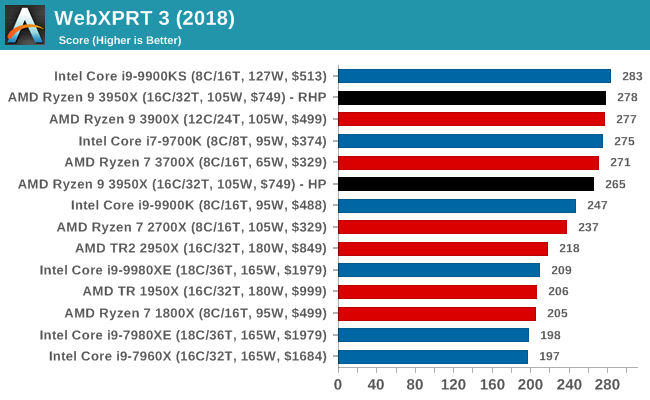
WebXPRT 2015: HTML5 and Javascript Web UX Testing
The older version of WebXPRT is the 2015 edition, which focuses on a slightly different set of web technologies and frameworks that are in use today. This is still a relevant test, especially for users interacting with not-the-latest web applications in the market, of which there are a lot. Web framework development is often very quick but with high turnover, meaning that frameworks are quickly developed, built-upon, used, and then developers move on to the next, and adjusting an application to a new framework is a difficult arduous task, especially with rapid development cycles. This leaves a lot of applications as ‘fixed-in-time’, and relevant to user experience for many years.
Similar to WebXPRT3, the main benchmark is a sectional run repeated seven times, with a final score. We repeat the whole thing four times, and average those final scores.
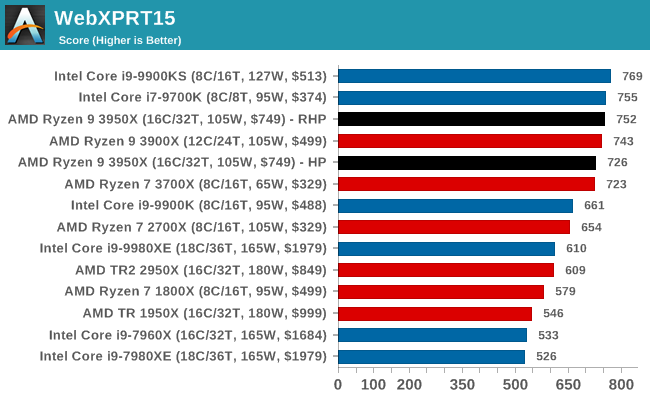
Speedometer 2: JavaScript Frameworks
Our newest web test is Speedometer 2, which is a accrued test over a series of javascript frameworks to do three simple things: built a list, enable each item in the list, and remove the list. All the frameworks implement the same visual cues, but obviously apply them from different coding angles.
Our test goes through the list of frameworks, and produces a final score indicative of ‘rpm’, one of the benchmarks internal metrics. We report this final score.
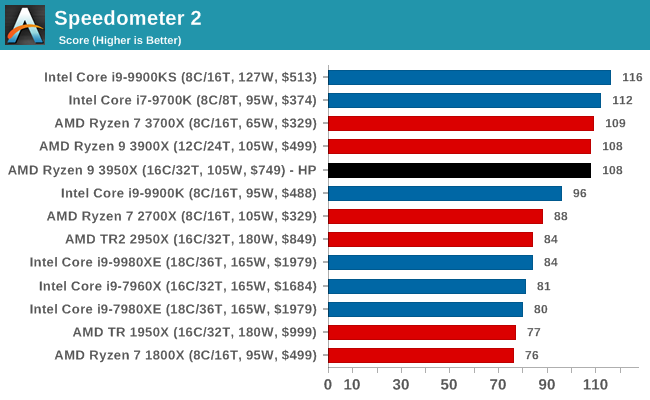
Google Octane 2.0: Core Web Compute
A popular web test for several years, but now no longer being updated, is Octane, developed by Google. Version 2.0 of the test performs the best part of two-dozen compute related tasks, such as regular expressions, cryptography, ray tracing, emulation, and Navier-Stokes physics calculations.
The test gives each sub-test a score and produces a geometric mean of the set as a final result. We run the full benchmark four times, and average the final results.

Mozilla Kraken 1.1: Core Web Compute
Even older than Octane is Kraken, this time developed by Mozilla. This is an older test that does similar computational mechanics, such as audio processing or image filtering. Kraken seems to produce a highly variable result depending on the browser version, as it is a test that is keenly optimized for.
The main benchmark runs through each of the sub-tests ten times and produces an average time to completion for each loop, given in milliseconds. We run the full benchmark four times and take an average of the time taken.

3DPM v1: Naïve Code Variant of 3DPM v2.1
The first legacy test in the suite is the first version of our 3DPM benchmark. This is the ultimate naïve version of the code, as if it was written by scientist with no knowledge of how computer hardware, compilers, or optimization works (which in fact, it was at the start). This represents a large body of scientific simulation out in the wild, where getting the answer is more important than it being fast (getting a result in 4 days is acceptable if it’s correct, rather than sending someone away for a year to learn to code and getting the result in 5 minutes).
In this version, the only real optimization was in the compiler flags (-O2, -fp:fast), compiling it in release mode, and enabling OpenMP in the main compute loops. The loops were not configured for function size, and one of the key slowdowns is false sharing in the cache. It also has long dependency chains based on the random number generation, which leads to relatively poor performance on specific compute microarchitectures.
3DPM v1 can be downloaded with our 3DPM v2 code here: 3DPMv2.1.rar (13.0 MB)
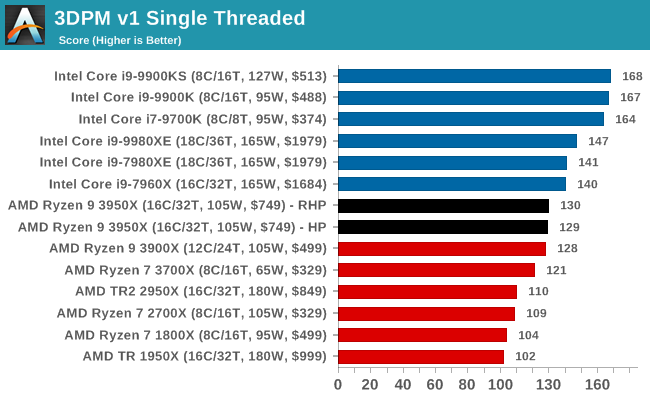
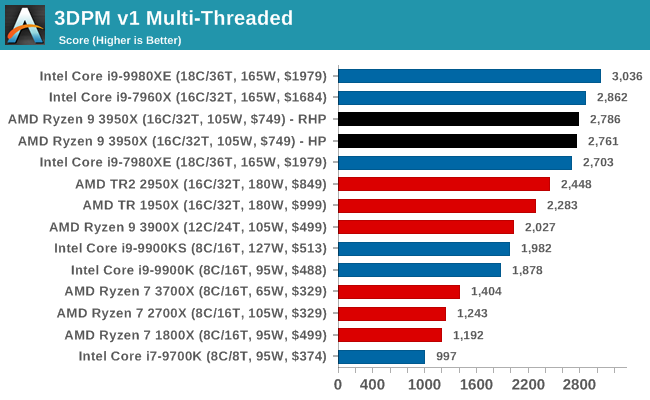
x264 HD 3.0: Older Transcode Test
This transcoding test is super old, and was used by Anand back in the day of Pentium 4 and Athlon II processors. Here a standardized 720p video is transcoded with a two-pass conversion, with the benchmark showing the frames-per-second of each pass. This benchmark is single-threaded, and between some micro-architectures we seem to actually hit an instructions-per-clock wall.
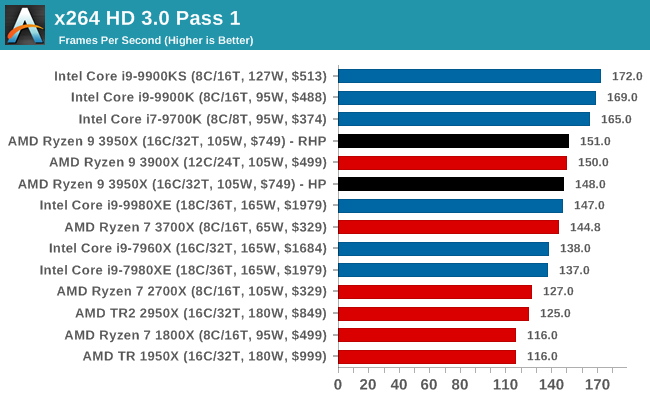
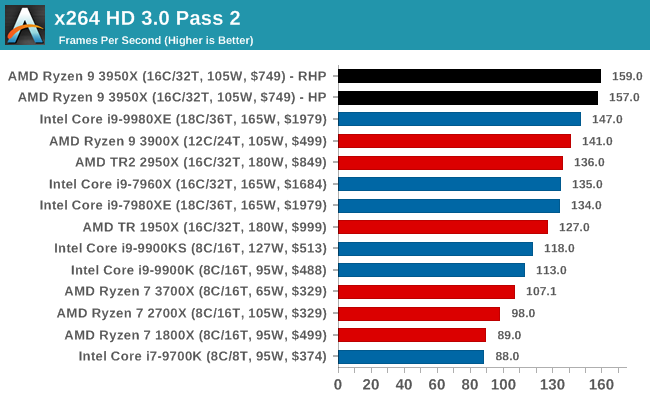
GeekBench4: Synthetics
A common tool for cross-platform testing between mobile, PC, and Mac, GeekBench 4 is an ultimate exercise in synthetic testing across a range of algorithms looking for peak throughput. Tests include encryption, compression, fast Fourier transform, memory operations, n-body physics, matrix operations, histogram manipulation, and HTML parsing.
I’m including this test due to popular demand, although the results do come across as overly synthetic, and a lot of users often put a lot of weight behind the test due to the fact that it is compiled across different platforms (although with different compilers).
We record the main subtest scores (Crypto, Integer, Floating Point, Memory) in our benchmark database, but for the review we post the overall single and multi-threaded results.

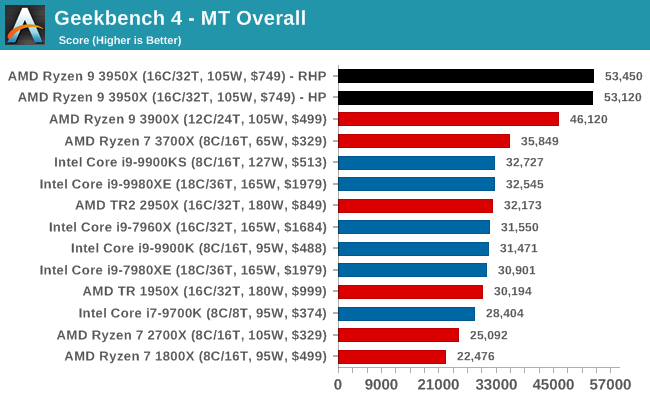










206 Comments
View All Comments
nathanddrews - Friday, November 15, 2019 - link
That's typically the main problem: minimum frames. Across most benchmarks, Intel can maintain significantly higher minimum frame rates for 144Hz and up. Obviously these metrics are going to be very game-dependent and settings-dependent, but the data are very clear: Intel's higher frequencies give it a significant advantage for minimum frames.treichst - Thursday, November 14, 2019 - link
165hz monitord have existed for a while now. 240hz monitors exist from a number of vendors.RedGreenBlue - Thursday, November 14, 2019 - link
The reason this is okay is the same reason a lot, or most, car engines advertise a.b liter engines when in reality it’s about a.(b - 0.05). It’s a generally accepted point of court precedents, or maybe in the laws themselves, that you can’t sue for rounding, unless it’s an unreasonable difference from the reality. So if you want to sue AMD, expect to be laughed out of court.shaolin81 - Friday, November 15, 2019 - link
Problem most probably relies on using High performance profile. When I use it with my 2700X, idle cores are nearly never parked and therefore there's no room for CPU to get Max Turbo on a single core. When I change it to balanced profile, I most idle cores are parked and I get beyon Max Turbo easily - to 4450Mhz. Anandtech should try this.prophet001 - Friday, November 15, 2019 - link
I think that's me too nathanddrews. I mostly play WoW and though I haven't seen any actual benchmarks, I'm pretty sure that the 9900KS will outperform the Ryzens. WoW just scales with clock speed past like 4 cores.SRB181 - Friday, November 15, 2019 - link
I've often wondered what people are looking for when cpu's get to this point. I'm absolutely positive the 9900ks will outperform my current CPU (1950x), but I'm getting 78 fps at 4k60 in WOW set to ultra (10) in the graphics. Not being a jerk, but what exactly do you notice in gameplay with 9900ks that I would notice/see?prophet001 - Monday, November 18, 2019 - link
I don't have a 9900 I've just seen how WoW behaves with various processors and my own personal experience. I have an old extreme processor x299 chipset with a 1080 GTX. It's highly CPU bound. Even though the processor is 4 core hyper threaded, it won't get past like 45 FPS in Boralus. I know it's not GPU bound because I look at the GPU load in GPU-z and it's like 40% load. I can turn render scale up or down and doesn't really make a difference on my computer.That, along with other people's research, leads me to believe that WoW is highly CPU bound but more specifically, core clock speed bound. People that get 5GHz get much more out of the game than people that leave their CPUs at stock clocks.
Qasar - Monday, November 18, 2019 - link
prophet001 there must be something else going on with your system, as i type this i am sitting in Boralus harbor, right above where the ship from SW docks looking out towards the mountain, with the ship from SW coming into dock on the left. i am getting a minimum of 65 FPS as i spin in the spot. im running a Asus stix, 1060 gaming, with a i7 5930K @ 4.2 ghz. @ 1080P in other zones, i have seen as high as the 180s.... cpu and GPU utilization is 30-40% and a solid 25% respectfully.maybe there is something else with your system that is causing this ?
Qasar - Monday, November 18, 2019 - link
should also mention, thats with pretty much max on the graphics options.WaltC - Friday, November 15, 2019 - link
Wrong answer...;) AMD has only ever said "Max single core boost", emphasis on the word "max," which evidently must be translated for the benefit of people mindlessly trying to pick it apart because the meaning of "max" ever eludes them!...;) Really, I've seen all kinds of stupid come out on this one. AMD does not say, "guaranteed single core boost of 4.7GHz" because it's not guaranteed at all--it is the "max" single-core boost obtainable--not the "only" single-core boost the CPU is capable of! Uh--I mean, I'm embarrassed I actually have to explain this, but *any single-core boost clock above the base clock of the cpu* is a *genuine boost of the core* and "max" of course means only the very maximum single core boost clock obtainable at any given time, depending on all of the attendant conditions! So, take a situation in which all the cores boost to 4.5Ghz, 4.6GHz or 4.3Ghz--every single one of them is providing the advertised single-core boost! And yes, people are indeed seeing 4.7GHz *maximums*--but not all of the time, of course, since "max" doesn't mean "all of the time every time," does it,? In their zeal to defend an otherwise indefendable Intel--people have completely butchered the "max" single core boost concept (well, Intel people have butchered it, I should say..;)). Gee--if the only boost these CPUs ever did was 4.7GHz, then none of them would be "max," would they--they'd be the *normal clock* and the damn CPU would be running at 4.7GHz continuously on all cores!...;) I mean, is it possible for people to wax anymore stupid on this subject than this? "Max" absolutely does not mean "all the time every time"--else "max" would have no meaning at all. Jeez--the stupid is strong @ Intel these days...;) Also, it's interesting to note that with fewer cores and a slower clock AMD processes data *faster* than Intel even though the Intel CPU has more cores and a higher clock--so please, the confusion over "max single core boost clocks" from AMD is just plain dumb, imo. It's plain enough--always has been. Multicore CPUs do not exist merely to see to what GHz a *single core* might reach @ maximum! Jeez--we graduated from single-thread thinking long years ago...;) (Or, rather, some of us did.)